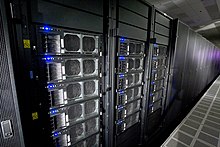IBM Roadrunner
Roadrunner was the unofficial name of a supercomputer based on an IBM BladeCenter QS22 cluster , which was installed at Los Alamos National Laboratory in the US state of New Mexico .
With a performance of 1.026 Peta - FLOPS , the Roadrunner set a new record on June 9, 2008 and came in first place on the TOP500 list. Since then, the system has been upgraded to 296 racks and with 1.105 Peta - FLOPS it held first place until the November 2009 list, in which it was overtaken by the Jaguar system. The schedule provided for day-to-day operations to start in October 2009. In total, the system cost around $ 133 million.
IBM built the supercomputer for the US Department of Energy (DOE). It has a hybrid design, consisting of 6480 AMD Opteron processors (3240 IBM LS21 blade servers, each containing two dual-core Opterons, linked by HyperTransport ). However, Roadrunner was not an amalgamation of a cell cluster and an Opteron cluster, but an Opteron cluster, in which each Opteron core was subordinate to a cell processor (connected to each other by PCI Express ), which took over the mathematical calculations for it resulted in a number of 12,960 cell processors.
Most of the computing power came from the cell processors: 1.3 PFLOPS Peak vs. 47 TFLOPS Peak of the Opterons. The processor architecture used for this was the Cell Broadband Engine (Cell BE), which was created in cooperation with Sony, Toshiba and IBM (STI) and was also used in Sony's PlayStation 3 game console . In the Roadrunner, however, a new Cell version called PowerXCell 8i was used, which was able to calculate two double-precision calculations in its 128-bit registers at a maximum speed of a little over 100 GFLOPS (for comparison: the Playstation -3 variant only managed 15 GFLOPS with double accuracy).
The Roadrunner used the Red Hat Enterprise Linux and Fedora operating systems . The Cell processors were delivered as IBM Cell Blades and connected directly to the x3755 Opteron nodes by InfiniBand . The system was put into operation on June 8, 2008. The US Department of Energy has used the Roadrunner for simulations relating to the aging of radioactive substances, including nuclear weapons (see Advanced Simulation and Computing Program ). Nuclear weapons tests were simulated and verified that the United States' aging nuclear arsenal is safe and reliable. Other areas of application of the computer included simulations and calculations for science, finance, the automotive industry and aerospace.
The system finally went out of service on March 31, 2013. This procedure was justified with its poor energy efficiency, especially in comparison to other supercomputers.
Web links
- IBM to Build World's First Cell Broadband Engine Based Supercomputers . IBM. September 6, 2006. Retrieved September 11, 2006.
- Los Alamos National Laboratory Roadrunner Home Page . Los Alamos National Laboratory. March 30, 2007. Retrieved March 30, 2007.
-
IBM and AMD build hybrid supercomputers . Heise publishing house. September 6, 2006. Retrieved August 6, 2007.
- IBM introduces blade server module with cell processors . Heise publishing house. September 13, 2006. Retrieved August 6, 2007.
Individual evidence
- ↑ Roadrunner cracks the PetaFLOPS trademark , accessed June 10, 2008
- ↑ a b c Roadrunner Platform Overview ( Memento from October 23, 2013 in the Internet Archive ) (PDF; 1.4 MB) March 13, 2008
- ↑ http://www.golem.de/0806/60251.html , October 30, 2009
- ↑ Roadrunner with AMD power, first PFLOPS computer in the world June 10, 2008
- ↑ Roadrunner: Hardware and Software Overview. (PDF; 2.2 MB) IBM , October 10, 2008, accessed on September 7, 2013 (English).
- ↑ World's top supercomputer from '09 is now obsolete, will be dismantled-IBM Roadrunner, the first petaflop machine, goes offline today. arstechnica.com, March 31, 2013 , accessed May 2, 2015
